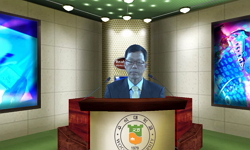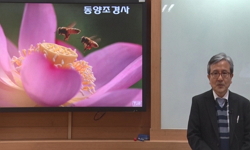우리나라의 전통 민속마을이 세계문화유산에 등재되고 전통마을에 대한 재인식과 함께 전통 생태학적으로 중요도가 높아가는 시점에 와 있다. 전통 문화경관이 우수함은 인정되나 재정...
http://chineseinput.net/에서 pinyin(병음)방식으로 중국어를 변환할 수 있습니다.
변환된 중국어를 복사하여 사용하시면 됩니다.
- 中文 을 입력하시려면 zhongwen을 입력하시고 space를누르시면됩니다.
- 北京 을 입력하시려면 beijing을 입력하시고 space를 누르시면 됩니다.
성주 한개마을의 전통경관 해석에 관한 연구 = A Study on the Interpretation of the Traditional Landscapes at Hangye Village, Seongju
한글로보기https://www.riss.kr/link?id=T13444072
- 저자
-
발행사항
서울 : 상명대학교 대학원, 2014
-
학위논문사항
학위논문(박사) -- 상명대학교 대학원 , 환경자원학과 환경조경 , 2014. 2
-
발행연도
2014
-
작성언어
한국어
- 주제어
-
발행국(도시)
서울
-
형태사항
254 p. ; 26 cm
-
일반주기명
지도교수: 이행렬
- 소장기관
-
0
상세조회 -
0
다운로드
부가정보
국문 초록 (Abstract)
우리나라의 전통 민속마을이 세계문화유산에 등재되고 전통마을에 대한 재인식과 함께 전통 생태학적으로 중요도가 높아가는 시점에 와 있다.
전통 문화경관이 우수함은 인정되나 재정비 복원함에 있어 정원경관의 가치성과 의미에 대한 인식부족으로 제대로 복원되고 있지 못하고 있는 현실이다. 따라서 본 연구에서는 전통 마을이 가지고 있는 특징들을 정원문화경관이라는 틀 속에서 되살릴 수 있는지에 대해 연구 하고자 하였다.
연구의 대상지로는 경북 성주군 월향면 대산리에 위치한 ‘한개마을’로서 마을이 형성되기 시작한 입향조 이후부터 현재까지를 범위로 잡았다. 연구의 구성은 서론, 관련기초이론, 한개마을의 문화경관, 생태경관, 전통정원들의 해석과 전통경관 보전, 결론으로 구성 하였다.
제 1 장 서론의 연구사에서는 전통마을, 전통정원, 생태경관에 대해 조사 하였는바 자연과 순응하는 형태에 대한 연구와 적용되는 방법, 마당으로의 구분, 시문학을 통한 의경 파악, 생태적으로 인간과 자연이 순응하는 마을로 평가 되였지만, 현대에 와서 친환경적이지 못한 기법으로 복원되고 있는 점도 지적 되었다.
제 2 장에서는 기초이론 으로서 전통마을의 개념과 정원, 경관, 생태에 대한 특징과 배식기법, 마당의 구성요소 등을 살펴보았고, 물의 이용과 점경물에 대한 정원 기법들을 살펴보았다. 전통정원의 특징은 자연에 순응하기 위해 풍수지리와 전통 생태기법을 적용하였으며 오랜 체험을 통한 식재문화와 선비문화가 발달하였음을 알게 되었다.
제 3 장에서는 한개마을에 대한 해석으로 마을의 역사성, 형성 유래, 인물 그리고 교육과 문화경관을 살펴보고 한개마을의 정체성과 진정성을 파악 하였다. 또한 응와와 한주의 한개마을과 관련된 시문을 분석하고 문화경관의 특징을 해석하여 한개마을의 가치성과 의의를 찾아내었다.
제 4 장에서는 마을의 경관 구조 해석을 위해 마을의 입지 특성을 GIS를 통해 분석하고 풍수지리 형국 등을 밝혔으며, 생태적 토지이용과 배치관계에 관한 특징을 밝혔다. 특히 마을길에 대한 경관적 우수성을 실측한 자료들을 이용해 D/H비를 분석하여 쾌적성에 대해 유형별로 파악 하였다.
제 5 장에서는 전통마을이 가지고 있는 정원의 전통성을 해석하기 위하여 문화재 지정지역과 비지정지역, 교육문화지역으로 구분하여 조사된 자료를 도면화 시켰으며 이를 토대로 정원의 특성을 파악 하였다. 또한 시각경관에 관하여도 그 특징을 조사하여 해석하였다.
제 6 장에서는 이상의 결과를 토대로 하여 전통마을의 경관구조를 가거지(可居地)), 가유지(可遊池), 가관지(可觀池), 가양지(可養池)지라는 측면에서 파악할 수 있었으며, 한개마을의 전통성 복원과 관련하여 현재 진행되는 개발 사업이 갖는 문제점과 이에 대한 대책을 제안 하였다.
결론으로 본 연구를 통해 한개마을의 전통성과 관련된 경관의 해석을 밝힐 수 있었고, 향후 본 논문에서 도출된 가치성과 문제점이 현장에서 활용되어져 전통마을의 진정성이 유지되기를 바란다.
다국어 초록 (Multilingual Abstract)
Traditional folk villages in South Korea are putting on the World Cultural Heritage and they are at a point time that rising the importance of traditional ecosystem with reconsidering the traditional village. Traditional landscape receives much reco...
Traditional folk villages in South Korea are putting on the World Cultural Heritage and they are at a point time that rising the importance of traditional ecosystem with reconsidering the traditional village.
Traditional landscape receives much recognition but it is true that it is not properly restored because of insufficiency about the value and meaning of garden landscaping in reorganization restoration.
therefore, this experiment has tried to put efforts on restoring characters of the traditional village within the range of garden-cultural landscaping.
‘Hangye Village’ located in Waulhyang-myun, Sungju-gun, Kyungbuck-si, South Korea is the site for this experiment. it ranges from ephyangjo(the originator building village) up to now.
the Index of experiment consists of Introduction, related-basic theory, cultural landscaping of ‘Hangye Village’, ecologic landscaping, interpretation of traditional garden, conservation of traditional landscaping, and conclusion.
As an introduction to research, by analyzing about traditional village, yard, and ecological landscape, although it gained reputation on experiment and applicable way of naturally adapted system, division of yard, symbolizing eulkyung(literature reminding of site and material) through prose and poetry, and ecological village adapted with people and the nature, today it has been pointed out that non-environmental technologies have been proceeding.
As an the second chapter, it examined the general idea of traditional village, the characters of garden, landscape and ecosystem, planting technology, and elements of a yard. also, it also looked over garden technologies about usage of the water and Jumkyungmul(the things displayed for attraction in a garden).
the characters of traditional garden was based on Chinese geomantic principles and traditional ecological technology for being adaptable to the nature, also it has been developed planting culture and the Sien-pi culture through learning from experience of long standing.
As an the third chapter, by understanding ‘Hangye Village’, It examined village’s history, origin, people, education, and cultural landscape and grasped the true characters of village.
Also, by analyzing prose and poetry related to eung Wa and han Ju and understanding characters of the cultural landscaping, it discovered the value and meaning of ‘Hangye Village’.
As an the fourth chapter, for understanding construction of ‘Hangye Village’ landscaping, conditions of location was analyzed by GIS and then, it explained the meaning of a facet of Chinese geomantic principles and ecological land usage and block planning.
Especially ,by using materials for village path landscaping’s excellency, it analyzed D/H proportion and classifies amenity as a several types.
As an the fifth chapter, for examining tradition of garden which traditional village includes, by classifying as a cultural heritage designated site, a non-designated site and an educational- cultural site, A plan is drawn by investigated dates. Following that, it helped to understand characters of garden and visual landscaping.
As an the sixth chapter, as a result of previous dates, it leaded to apprehend traditional village’s landscape construction as views of Gaguji, Gayouji, Gaghanji, and Gayangji (the place good to live, play, sightsee, and get knowledge) and as relating to restore ‘Hangye Village’ tradition, there are suggestions that what is the problem of present-progressing development businesses and how to solve this problem.
In conclusion, through this experiment, understanding of landscape related to ‘Hangye Village’ tradition can be recovered and in the future, It hopes to keep ‘Hangye Village’ authenticity by applying the value and problem derived from this treatise to the field.
목차 (Table of Contents)
- 제 1 장. 서론
- 제 1 절. 연구의 배경 및 목적 1
- 1. 연구의 배경 1
- 2. 연구의 목적 2
- 제 2 절. 연구 범위와 방법 3
- 제 1 장. 서론
- 제 1 절. 연구의 배경 및 목적 1
- 1. 연구의 배경 1
- 2. 연구의 목적 2
- 제 2 절. 연구 범위와 방법 3
- 1. 연구의 범위 3
- 2. 연구의 방법 6
- 제 3 절. 연구사 9
- 1. 전통마을의 경관 해석 9
- 2. 한개마을 20
- 제 4 절. 소결 24
- 제 2 장. 관련 기초 이론
- 제 1 절. 전통마을의 개념과 입지 25
- 1. 전통마을의 개념 25
- 2. 전통마을의 입지 특성 27
- 제 2 절. 전통정원의 개념과 기법 31
- 1. 전통정원의 개념 31
- 2. 전통정원의 기법 33
- 제 3 절. 전통경관의 개념과 해석 48
- 1. 전통경관의 개념 48
- 2. 전통경관의 해석 49
- 3. 자연경관과 문화경관 52
- 4. 문화와 생태경관 54
- 제 4 절. 소결 56
- 제 3 장. 한개마을의 문화경관 해석
- 제 1 절. 한개마을의 발전과정 58
- 1. 마을의 역사 58
- 2. 마을의 형성 58
- 3. 마을의 입향조 60
- 4. 마을의 인맥 63
- 5. 교육과 문화경관 67
- 제 2 절. 시문에 나타난 경관 인식 75
- 1. 응와의 시문과 경관 인식 75
- 2. 한주의 시문과 경관 인식 85
- 3. 응와와 한주 시문의 장소성 96
- 제 3 절. 소결 99
- 제 4 장. 한개마을의 생태경관 해석
- 제 1 절. 마을의 입지 특성 100
- 1. 한개마을의 형태 100
- 2. 풍수지리 103
- 3. 생태적 입지 108
- 제 2 절. 마을의 생태적 경관 체계 111
- 1. 건축물과 생태적 배치 111
- 2. 마을길의 경관 구조 114
- 3. 수로 체계 125
- 4. 녹지 체계 127
- 제 3 절. 소결 129
- 제 5 장. 한개마을의 전통정원 해석
- 제 1 절. 주택의 정원과 전통성 131
- 1. 문화재 지정지역의 주택 정원 131
- 2. 문화재 비지정지역의 주택정원 174
- 제 2 절. 한개마을의 시각적 경관 특성 220
- 제 3 절. 정원과 재식의 특징 228
- 제 4 절. 소결 230
- 제 6 장. 한개마을의 전통경관과 보전
- 제 1 절. 전통경관 해석의 체계 232
- 제 2 절. 마을의 전통경관 보전 방안 235
- 제 3 절. 소결 239
- 제 7 장. 결론
- 제 1 절. 연구의 결과 240
- 제 2 절. 연구의 한계점 243
- 제 3 절. 향후 방향 244
- 인용 및 참고문헌 246
- ABSTRACT 251









